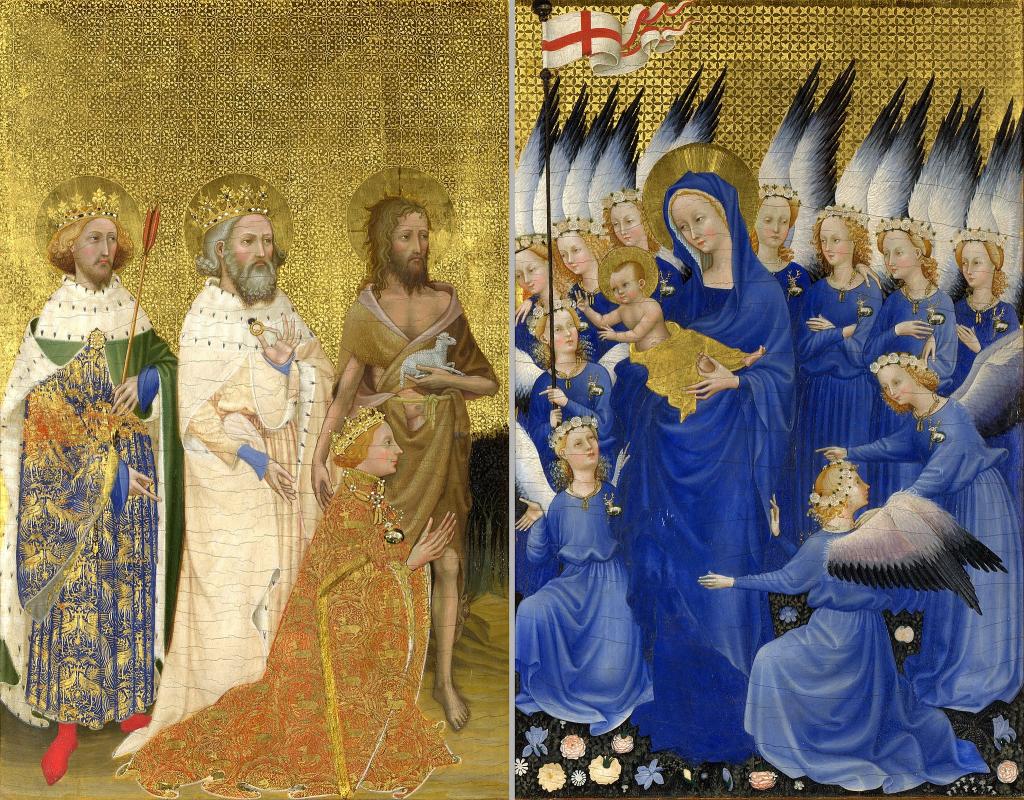A reflection for the Re-dedication of England as Mary's Dowry
One of the treasures of the National Gallery is the Wilton Diptych, a mediaeval portable altarpiece from the late 14th century. It consists of two pieces of wood, hinged together and beautifully painted on all four sides. The Diptych is immensely rich in the materials used, in the skills of the unknown artist and in its meaning. Its name, Wilton, comes from the House of the Earl of Pembroke where it remained from 1705 until its acquisition for the nation in 1929.
The Diptych tells an important part of the story of this nation. It is known as a 'donor portrait' and it depicts the exchange of gifts between Mary with the child Jesus and King Richard II, with his patron saints. Richard is offering the nation to the Virgin and child; the Child Jesus presents to Richard the symbolic pennant of his reign and Kingdom. The Diptych, then, is an expression of the tradition that there is a special relationship between this land and the Mother of Jesus. England is the 'Dowry of Mary', a gift given into her special keeping. Through the action of its King, and in keeping with an already established tradition, England is given to Mary, and Mary gives to England her special protection.
The Diptych was painted somewhere in between 1395 and 1399. Richard had been King for 18 years (in 1395) and they had not been easy years. He had inherited a land depopulated and devastated by the Black Death. The surviving population was riven with warring factions. Every possible help was needed. This dedication, then, reflected not only a pressing need but also a deeply rooted source of energy that was cultural and religious, for the two were inseparable. Not many years later, in 1415, on the eve of the Battle of Agincourt, the same invocation was made on behalf of the men who faced mortal danger and the highest possible stakes the following morning.
Centuries have passed and the challenges we face today are of a different measure. But our human nature has not changed. We struggle again with the need to find every possible resource to hold us together in the face of real danger. We need courage, generosity and dedication. We need the inspiration of every patron to whom we can turn.
These scenes turn our minds to the moment of another death: that of Jesus on the Cross of his self-sacrifice. At that moment he turns to his Mother and to his young disciple, John, saying to him that his Mother, Mary, is now Mother of John and through him Mother of us all. He gives her to us and entrusts us to her in an action that has echoed down through history ever since. That gesture gives rise to all that the Wilton Diptych, in its splendour, portrays so magnificently.
Over the last few years, the Catholic community in England and Wales has been preparing for a special moment in which we can respond today to the action of Jesus in a manner that reflects the response of Richard II. In doing so we had no idea that this act of rededication of our land and all its people to Mary, our Mother, would take place in the days of this epidemic. Yet that is what will happen, for we have designated the 29th March as the day for this rededication. Nor did we know, when this was planned, that at this time we would be keeping to a discipline of social distancing. Yet our planning was always that this rededication should be an act of an individual or family devotion, coming together to offer themselves and their lives to the Blessed Mother, reciting together the traditional and designated prayers. And that is what it will be.
This is an open invitation. It is an invitation deeply rooted in the old identities of this country and has a particularly English flavour as it is focused on the title of Mary as Our Lady of Walsingham, the place of her appearance and once a centre of European travel. Yet it has a world-wide appeal, for this devotion to Mary has spread throughout the globe and finds its expression in so many different cultures and places. This is ours.
If you wish to know more of this moment of spiritual dedication, especially in our hour of need, then please go to its website: Please take up its suggestions and add your gifts to the Dowry we wish to entrust to Our Blessed Lady and embrace the protection and strength she will give.
Standing at the moment of the death of her Son, Mary lived the reality of her title 'Mother of Sorrows'. We turn to her in all our sorrows and distress. But she also enjoys the title of 'Mother of Joys', for she beheld the miracles of her Son and his rising from the dead, with its promise of eternal life for all of God's sons and daughters. She brings these joys to us too.
May this Blessed Mother of Sorrows be with us all today. May her Joys also penetrate our lives so that we can live these difficult days with unshakable confidence and a persistent hope.
Image: National Gallery/Public Domain
